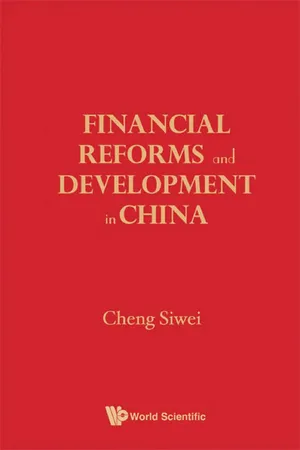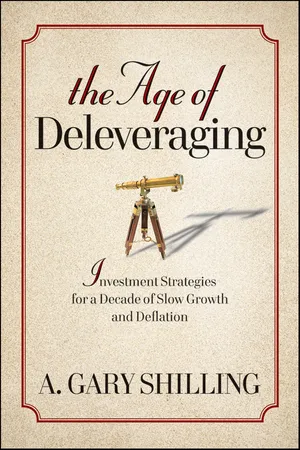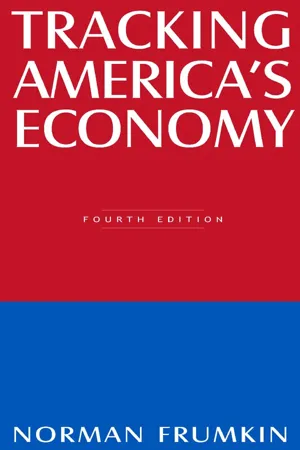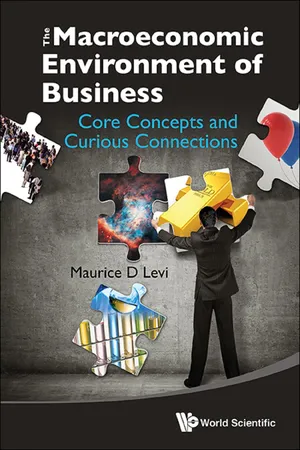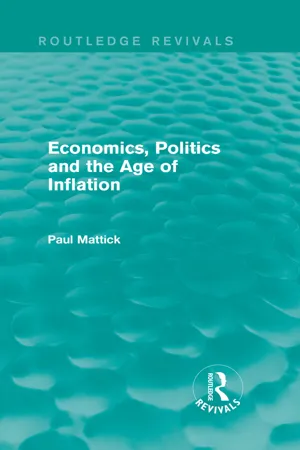Economics
Deflation
Deflation refers to a sustained decrease in the general price level of goods and services within an economy. This can lead to reduced consumer spending and investment, as individuals and businesses anticipate further price declines. Deflation can also increase the real burden of debt, making it more difficult for borrowers to repay loans.
Written by Perlego with AI-assistance
Related key terms
9 Key excerpts on "Deflation"
- Mark Mobius(Author)
- 2020(Publication Date)
- Wiley(Publisher)
67*Murray N. Rothbard, economist, historian, and political theorist: “‘Deflation' is usually defined as generally falling prices, yet it can also be defined as a decline in the money supply which, of course, will also tend to lower prices. It is particularly important to distinguish between changes in prices or the money supply that arise from voluntary changes in people's values or actions on the free market; as against deliberate changes in the money supply imposed by governmental coercion.”68Central Banks Cause Deflation
*Peter Cresswell: “There are two kinds of ‘Deflation’: progressive and destructive. Central banks and their ‘stabilisation' make the first impossible, and the second more likely.”69Deflation Is Caused by an Increased Production of Goods and Services
*George Reisman, professor emeritus of economics at Pepperdine University: “Deflation is usually thought to be a synonym for falling prices. There could be no more serious error in all of economics. Calling falling prices ‘Deflation’ results in a profound confusion between prosperity and depression. This is because the leading cause of falling prices is economic progress, whose essential feature is an increasing production and supply of goods and services, which, of course, operates to make prices fall.”70People Should Accept Deflation
*Carlos Ghosn, chairman and CEO of Groupe Renault: “To face Deflation, you have to have people accepting it and not reacting to it.”71Deflation Is Bad
*Robert Kiyosaki, founder of Rich Dad Company: “Deflation isn't good, and inflation is easier to cure than Deflation.”29*Lawrence Summers, former director of the National Economic Council: “Deflation and secular stagnation are the macroeconomic threat of our time.”72*Jack Kemp, former US secretary of housing and urban development: “The real problem is Deflation. That is the opposite of inflation but equally serious to the borrower.”- eBook - ePub
The Coming Bond Market Collapse
How to Survive the Demise of the U.S. Debt Market
- Michael G. Pento(Author)
- 2013(Publication Date)
- Wiley(Publisher)
stable means not easily moved. However, to the men and women who control our money supply, it means increasing about 2 percent a year. So determined are they that the economy not be met by the evil Deflationary monster that they create inflation of 2 percent (as measured by the phoniest of inflation measurements known as the Personal Consumption Expenditure Price Index). This is done as a buffer or wall to block evil Deflation from coming in—because once that evil Deflation monster enters the economy, they fear he will never leave.The word Deflation is a little nebulous in that it is used by economists in a technical way to describe a decline in the money supply. Most laypeople view Deflation as a generalized decline in prices. Inflation , in turn, would refer to an increase in prices or, more technically speaking, an increase in the money supply or the fear of such a future increase in its supply that causes a decline in the purchasing power of the currency.As a follow-up to my introduction on decreasing prices, I have decided to start my critique of Fed myths with the Keynesian Fed-lore of the “Deflationary death spiral”; this Fed-lore is very widely held and promulgated. The men and women at the Federal Reserve believe that a slight increase in prices is a sign of a growing economy and falling prices are devastating.Let’s put this Keynesian Fed-lore to the test and see how it holds up.In an economic environment of increasing productivity accompanied by a static money supply, one would assume that prices would slightly decrease. As an industry becomes more productive and makes better use of technology, those technological advances aid in the reduction of costs associated with producing the product. Profit margins improve, and in a competitive environment, businesses will pass most of these savings on to consumers. So with truly stable prices, the costs of many items would go down, and that would be a positive result; it would indicate that businesses were leveraging productivity to increase profit margins and decreasing the price of goods to consumers. However, outside of technology, we rarely see this materialize.Those at the Fed view any Deflation as harmful, regardless of the cause. Ben Bernanke has said that “Deflation is in almost all cases a side effect of a collapse in aggregate demand—a drop in spending so severe that producers must cut prices on an ongoing basis in order to find buyers.”1 - eBook - ePub
- Cheng Siwei(Author)
- 2013(Publication Date)
- WSPC(Publisher)
3.4. Causes and Consequences of Modern Deflation
The causes for Deflation are complicated — requiring more extensive and in-depth research work — but there has been no general academic consensus so far.The earliest person to systematically study Deflation is the U.S. economist, Irving Fisher. When he was studying the Great Depression in 1929–1933, he advocated that the initial excessive debt and the subsequent Deflation were the two major variables. When the equilibrium in economic system was destroyed by excessive debts, the liquidity of debt will trigger the following nine chain reactions assuming there were no other contributors factors affecting price: (1) cheap sale of assets; (2) shrinking saving deposits and slowing circulation; (3) falling prices; (4) accelerating corporate insolvencies; (5) lowered profits; (6) contraction of industry and commerce; (7) spread of pessimism and loss of confidence; (8) further drop of currency circulation and; (9) rise of real interest rate concomitant with drop in nominal interest rate.These nine steps of chain reactions do not necessarily follow the chronological order they have been listed: there will exist some other reactions of which certain individual steps might be repeated. Except for the first and the last reaction or step in the logical sequence (debt and its interest rate), all other changes stem from falling of prices. It is also note-worthy that the decline in cash supply, savings and the speed of circulation of money also has a direct impact on the decline of the transaction volume.Excessive debt will lead to Deflation, and Deflation will in turn raise the actual scale of outstanding debt. When excessive debts exceed the threshold scale, the more the debtors pay back, the more debts they owe, thus creating a vicious cycle. For example in the case of U.S., the Great Depression begun in 1929, by September 1933, as the aggregate price level dropped by an accumulated 75%, the real debts had actually increased by 40% [(100% – 20%) × (100% + 75%) – 100% = 40%] even though the liquidation of debt has lessened 20% of the nominal debt volume. Under such circumstances, output and real income would drop sharply and continuously, adding more instability to the economy. - Imad A Moosa(Author)
- 2013(Publication Date)
- WSPC(Publisher)
Chapter 1INFLATION, Deflation, DISINFLATION AND ALL THAT1.1.What is Inflation?It is often said that inflation is inevitable, like death and taxes. This is probably because, as Sir Frederick Keith-Ross mentions, “inflation is like sin; every government denounces it and every government practices it” (Makochekanwa, 2007). Historical stories about inflationary episodes proves that it is a phenomenon that has existed ever since money was used as a medium of exchange. Inflation is a topic that receives significant attention in the media, with regular features, reports and interviews. It is an issue that is often debated by politicians in Parliament and election campaigns, let alone economists and business executives.The reason why inflation is treated with “respect” is that it affects everybody in various ways. It is an important consideration during mortgage payments and in determining the cost of essential goods and services required for survival and those that make our lives more pleasant. We anticipate news about whether the central bank will decide to cut or raise interest rates, with inflation typically being the prime consideration (at least for some central banks). Most of us are fascinated by documentaries on the great inflation in Germany during the 1920s and how it relates to the rise of Adolf Hitler. Inflation has broad implications for the state of the economy and whether or not we can keep our jobs or find new ones. While it is regarded as one of the four macroeconomic variables closely monitored by policymakers (the others being growth, employment and the balance of payments), it is often the prime indicator that triggers drastic policy actions. “Inflation targeting” is a more common concept than “output targeting”, “employment targeting” or “balance of payments targeting”.Inflation is defined in different ways, but, in general, the phenomenon is about rising prices of goods and services (hence, the cost of living). As the prices of goods and services rise, the value (or purchasing power) of money falls in the sense that a monetary unit (say a dollar) buys less and less goods and services resulting in a diminishing basket. This is why inflation is viewed as a “persistent” erosion of the value of the money. While it cost 60 pounds to purchase a first class ticket on the Titanic in 1912, there is no way these days that this amount can buy a ticket to cross the Atlantic (let alone the Pacific) in a first class cabin on an ocean liner (perhaps 10,000 pounds can do the job). It is for this reason that we give our children more pocket money than what our parents gave us. People are typically nostalgic to the “good old days” when things were very cheap — the culprit being inflation.- eBook - ePub
The Age of Deleveraging
Investment Strategies for a Decade of Slow Growth and Deflation
- A. Gary Shilling(Author)
- 2010(Publication Date)
- Wiley(Publisher)
Five of the seven forms of Deflation are in place, and are largely understood by investors. Increasingly, observers realize that cuts in wages and hours worked are being used to reduce labor costs in addition to layoffs (wage-price Deflation). The collapse in 2008 in commodities, and more recent weakness, is obvious to all (commodity Deflation). Commercial real estate Deflation is increasingly seen as another serious threat to the financial system and adds to housing price weakness (tangible asset Deflation). The 2000–2002 and 2007–2009 stock collapses as well as the more recent slide are vivid to most investors (financial asset Deflation). The dollar's strength in late 2008 and early 2009 as well as in early 2010 is well known.The least accepted variety of Deflation remains general price declines, or CPI Deflation, as we've dubbed it. If we're right and the CPI and PPI fall chronically by 2 to 3 percent per year, that will be a big shock to almost everyone else who expects the opposite. Unlike CPI inflation, which is generally considered undesirable, Deflation comes in two flavors: the good Deflation of excess supply and the bad Deflation of deficient demand.Good DeflationGood Deflation is driven by new, productivity-soaked technologies that expand supply faster than demand can catch up. Actually, new technologies aren't really new by the time they generate good Deflation. Think about computers. When first developed after World War II, they were physically huge and limited in potential size and computing power because, on a random basis, one of their thousands of vacuum tubes would burn out every minute or so and shut down the whole machine. Even after vacuum tubes were replaced by transistors, and later the development of PCs, computers had limited impact on the economy. Even though growing very rapidly in number and computing power, they started from a tiny base. Ditto for other post–World War II new technologies such as the Internet, telecommunications, and biotech. Only in recent years are they collectively becoming large enough to have importance. And Deflation-spawning productivity simply gushes from these new technologies, both in their production and their use. Think about the explosion in computer consumption in recent decades while prices, adjusted for mushrooming computer power, simultaneously collapsed. Note that in the 1930s, productivity grew a robust 2.39 percent annually as the new techs of the 1920s, which I explore later, mushroomed, despite the dire economy. For example, after a setback in the Great Depression, telephone usage leaped as it proved too useful to avoid even in tough times (see Figure 8.8 - eBook - ePub
- Norman Frumkin(Author)
- 2015(Publication Date)
- Routledge(Publisher)
11Inflation and Deflation
Prices influence and reflect many aspects of the private and government sectors of the economy. They are both a driving force and a culmination of the various elements of demand and supply in the marketplace. Different geographic, industrial, financial, real estate, and labor markets vary considerably in their competitive and monopolistic features, and prices are the summation of the varying degrees of market imperfections. Prices are also affected by extra-market considerations, such as war or threat of war, the environment, and natural disasters (e.g., drought, floods, earthquakes, tornadoes).Prices of goods and services vary considerably among individual items bought and sold in the marketplace. There is the intrinsic difference in the absolute price of one item in comparison to another at a point in time, such as the price of a car and of college tuition. There are continuing differences in the movements of prices over time, such as price changes of a car and of college tuition from one year to the next. Some items rise in price more than others, some decline in price more than others, and some are unchanged from one period to the next. These differential price movements reflect actual or perceived shortages or surpluses among buyers and sellers and varying degrees of price competition for particular items. Changes in overall price levels for the total of all goods and services are the net effect of the varying upward, downward, and stable movements of the vast number of items sold in markets around the United States.There are also varying degrees of inflation (price increases) and Deflation (price decreases) that have differential effects on the economy. In general, overall price movements affect the economic well-being of the population in the following way: people are better off if their incomes increase more than prices increase, or if their incomes fall less than prices fall. - eBook - ePub
The Macroeconomic Environment of Business
Core Concepts and Curious Connections
- Maurice D Levi(Author)
- 2014(Publication Date)
- WSPC(Publisher)
Figure 4.1 which describes U.S. inflation history over almost a century—shows that inflation—a rising price level—is far more frequent than Deflation—a declining price level—although there have been occasions, such as during the Great Depression, 1929–1933, when prices fell sharply.Fig.4.1. Almost a century of U.S. inflation and Deflation.Source: United States Bureau of Labor http://en.wikipedia.org/wiki/File:US_Historical_ Inflation.svg .Inflation rates can differ greatly between countries and within countries over time.In this chapter we explain possible causes of inflation. We also consider the effects of inflation and the importance of how accurately inflation is forecasted by savers, workers and others. As we shall see in later chapters, unanticipated inflation is in many ways more important than the rate of inflation itself, having an important bearing on other macroeconomic phenomena, including unemployment, GDP and interest rates. This is why we set out to deal with as many aspects of inflation as we can, all in one chapter; later chapters can then build on these foundations. However, before dealing with the causes and effects of inflation it is useful to consider how it is measured, and the accuracy of the alternative measures that are used. We shall see that as with most important macroeconomic variables, published inflation statistics are only estimates, requiring some care in interpretation.1MEASURING INFLATIONAs we are all well aware, inflation reduces the buying power of any given dollar amount of income or savings. The rate of inflation is measured by the rate at which an index of prices goes up (or goes down in the case of Deflation). The price index - eBook - ePub
- Paul Mattick(Author)
- 2017(Publication Date)
- Routledge(Publisher)
2 Deflationary InflationIt is popular nowadays to distinguish between the inflation of time past and a new kind of inflation, which accordingly requires a new explanation, although in its monetary aspects inflation has the same features now as before: rising prices or the diminishing buying power of money. While its opposite, Deflation, was viewed as contracted demand resulting in falling prices, inflation was explained by insufficient supply, driving prices up. Since, however, in this view it is the commodity market that determines price formation, little attention was paid to monetary policy. Money was seen merely as a veil concealing real processes, obfuscating them but altering little in their essential nature.This theory was also accompanied by the illusion, still lingering today, that the quantity of money in circulation in the economy has an important influence on commodity prices and that price stability depends on an equilibrium between the quantity of money and the total volume of goods. The modern advocates of the quantity theory of money also attribute Deflation and inflation to a too slow or too rapid growth in the supply of money, and as a remedy to these anomalies they propose the creation of money adjusted proportionally to actual economic growth.Thus in money theory the economic cycle is represented as an expansion and contraction of the money supply and of credit not commensurate with the real situation. But it was expected that the equilibrium mechanism of the market would ultimately steer things back to normal. The crisis of the thirties, however, which seemed to have taken hold for good, put an end once and for all to any notions of such an automatic self-establishing equilibrium. In Keynes's view, which dominated bourgeois economic theory in the years that followed, the laws of the market were no longer capable of bringing about economic equilibrium with full employment. A developed capitalist economy, claimed Keynes, made for a decline in effective demand and with it a fall-off in investments and growing unemployment. Although this theory was designed specifically to explain economic stagnation during the period between the two world wars, it was quickly given universal status and regarded as the last word in the science of economics; to avoid the Deflationary state of the depression and to restore economic equilibrium with full employment, state measures were needed to stimulate overall demand. - eBook - ePub
- Steven Horwitz(Author)
- 2002(Publication Date)
- Routledge(Publisher)
less than its specie holdings. Presumably any depositor of specie will want a receipt for that amount and that receipt serves as money. In addition, a bank that acquired specie on its own and then decided not to monetize it by lending it out would be sacrificing the interest earnings necessary to compensate for the cost of obtaining the specie. By ruling out absolute losses in specie from the definition of Deflation, Rothbard can only see Deflation as occurring after an inflation.In much of his discussion of the effects of inflation, Rothbard covers the standard Austrian ground of relative price effects, debtor-creditor redistributions, and the business cycle. He also recognizes that inflation is fundamentally a redistributive process. So much so that he is led to say that there is ‘no social utility in an increased supply, nor any social disutility in a decreased supply, of money. This is true for the transition period [between monetary equilibria] as well’ (1962:711).20 This is worded very carefully to leave open the possibility that inflation causes a decrease in utility and Deflation an increase therein, but his emphasis is surely on the redistributive processes at work in both inflation and Deflation. The nuances of that quote aside, in analyzing the effects of inflation, he is largely on target. What is interesting, but not surprising, is the dearth of attention paid to Deflation. In the 30-page section where he discusses the effects of inflation (as an instance of ‘the economics of violent intervention in the market’), his discussion of Deflation is less than two full pages. It occurs in the sub-section on ‘Secondary Developments of the Business Cycle’ and is mostly laudatory concerning the ways in which Deflation is necessary to undo the effects of the necessarily prior inflation. Even the redistributive aspect of Deflation is praised because it ‘takes away from the original coerced gainers [from inflation] and benefits the original coerced losers’ (1962:865). In addition, Deflation can, by definition, never go farther than bringing the money supply down to equal the supply of specie, thereby doing the desirable deed of eradicating the inflation.21
Learn about this page
Index pages curate the most relevant extracts from our library of academic textbooks. They’ve been created using an in-house natural language model (NLM), each adding context and meaning to key research topics.


